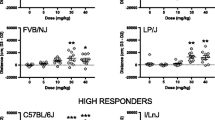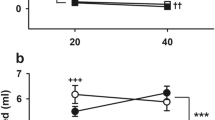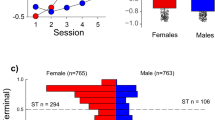Abstract
Rationale
Research indicates that genetics influence methamphetamine self-administration as well as sensitization to the psychomotor-stimulating effects of methamphetamine (MA). Other studies have suggested that heightened levels of impulsivity, including low levels of behavioral inhibition, are associated with the use of drugs, including MA.
Objectives
The current study examined whether lines of mice selected for traits associated with a heightened risk of developing MA dependence would also exhibit low levels of drug-naïve inhibition and whether administration of MA would result in different levels of inhibition in animals selected to consume or respond more to MA.
Methods
A go/no-go task was used to assess inhibition in male and female mice selected for low or high levels of MA consumption or selected for high or low levels of locomotor sensitization to repeated injections of MA.
Results
Mice selected for MA sensitization differed in false alarms, precue response rates (measures of behavioral inhibition), and also hits (measure of operant responding). Mice selected for MA consumption did not differ in measures of behavioral inhibition, though hits differed. When MA was administered prior to the task, false alarms, precue response rates, and hits decreased for mice from all selected lines. Female high drinking mice were particularly resistant to MA’s effects on hits, but not precue response rate or false alarms.
Conclusions
These data suggest a shared, but complex, genetic association between inhibition processes, general levels of operant responding, and MA sensitization or consumption.






Similar content being viewed by others
References
Agrawal A, Neale MC, Prescott CA, Kendler KS (2004) Cannabis and other illicit drugs: comorbid use and abuse/dependence in males and females. Behav Genet 34:217–228
Anker JJ, Gliddon LA, Carroll ME (2008) Impulsivity on a go/no-go task for intravenous cocaine or food in male and female rats selectively bred for high and low saccharin intake. Behav Pharmacol 19:615–629
Bizarro L, Stolerman IP (2003) Attentional effects of nicotine and amphetamine in rats at different levels of motivation. Pyschopharmacology 170:271–277
Bizarro L, Patel S, Murtagh C, Stolerman IP (2004) Differential effects of psychomotor stimulants on attentional performance in rats: nicotine, amphetamine, caffeine, and methylphenidate. Behav Pharmacol 15:195–206
Carroll ME, Anker JJ, Mach JL, Newman JL, Perry JL (2010) Delay discounting as a predictor of drug abuse. In: Madden GJ, Bickel WK (eds) Impulsivity: the behavioral and neurological science of discounting. American Psychological Association, Washington, pp 243–271
Cole BJ, Robbins TW (1987) Amphetamine impairs the discriminative performance of rats with dorsal noradrenergic bundle lesions on a 5-choice serial reaction time task: new evidence for central dopaminergic-noradrenergic interactions. Psychopharmacology 91:458–466
Cole BJ, Robbins TW (1989) Effects of 6-hydroxydopamine lesions of the nucleus accumbens septi on performance of a 5-choice serial reaction time task in rats: implications for theories of selective attention and arousal. Behav Brain Res 33:165–179
Crabbe JC, Phillips TJ, Kosobud A, Belknap JK (1990) Estimation of genetic correlation: interpretation of experiments using selectively bred and inbred animals. Alcohol Clin Exp Res 14:141–151
Dalley JW, Fryer TD, Brichard L, Robinson E, Theobald D, Laane K et al (2007) Nucleus accumbens D2/3 receptors predict trait impulsivity and cocaine reinforcement. Science 315:1267–1270
de Wit H, Crean J, Richards JB (2000) Effects of d-amphetamine and ethanol on a measure of behavioral inhibition in humans. Behav Neurosci 114:830–837
de Wit H, Enggasser MA, Richards JB (2002) Acute administration of d-amphetamine decreases impulsivity in healthy volunteers. Neuropsychopharmacology 27:813–825
Eagle DM, Baunez C (2010) Is there an inhibitory-response-control system in the rat? Evidence from anatomical and pharmacological studies of behavioral inhibition. Neurosci Biobehav Rev 34:50–72
Eagle DM, Tufft M, Goodchild HL, Robbins TW (2007) Differential effects of modafinil and methylphenidate on stop-signal reaction time task performance in the rat, and interactions with the dopamine receptor antagonist cis-flupenthixol. Psychopharmacology 192:193–206
Eagle DM, Robbins TW (2003) Inhibitory control in rats performing a stop-signal reaction-time task: effects of lesions of the medial striatum and d-amphetamine. Behav Neurosci 117:1302–1317
Eagle DM, Bari A, Robbins TW (2008) The neuropsychopharmacology of action inhibition: cross-species translation of the stop-signal and go/no-go tasks. Psychopharmacology 199:439–456
Evenden J (1999) Impulsivity: a discussion of clinical and experimental findings. J Psychopharmacol 13:180–192
Feola TW, de Wit H, Richards JB (2000) Effects of d-amphetamine and alcohol on a measure of behavioral inhibition in rats. Behav Neurosci 114:838–848
Fillmore MT, Rush CR, Marczinski CA (2003) Effects of d-amphetamine on behavioral control in stimulant abusers: the role of prepotent response tendencies. Drug Alcohol Depend 71:143–152
Frank MJ, O'Reilly RC (2006) A mechanistic account of striatal dopamine function in human cognition: psychopharmacological studies with cabergoline and haloperidol. Behav Neurosci 120:497–517
Frank MJ, Santamaria A, O’Reilly RC, Willcutt E (2007) Testing computational models of dopamine and noradrenaline dysfunction in attention deficit/hyperactivity disorder. Neuropsychopharmacology 32:1583–1599
Garris PA, Budygin EA, Phillips PEM, Venton BJ, Robinson DL, Bergstrom BP, Rebec GV, Wightman RM (2003) A role for presynaptic mechanisms in the actions of nomifensine and haloperidol. Neuroscience 118:819–829
Gubner NR, Wilhelm CJ, Phillips TJ, Mitchell SH (2010) Strain differences in behavioral inhibition in a go/no-go task demonstrated using 15 inbred mouse strains. Alcohol Clin Exp Res 34:1353–1362
Harrison AA, Everitt BJ, Robbins TW (1997) Doubly dissociable effects of median- and dorsal-raphé lesions on the performance of the five-choice serial reaction time test of attention in rats. Behav Brain Res 89:135–149
Harrison AA, Everitt BJ, Robbins TW (1999) Central serotonin depletion impairs both the acquisition and performance of a symmetrically reinforced go/no-go conditional visual discrimination. Behav Brain Res 100:99–112
Kendler KS, Jacobson KC, Prescott CA, Neale MC (2003) Specificity of genetic and environmental risk factors for use and abuse/dependence of cannabis, cocaine, hallucinogens, sedatives, stimulants, and opiates in male twins. Am J Psychiatry 160:687–695
Loos M, Stall J, Schoffelmeer ANM, Smit A, Spijker S, Pattij T (2010) Inhibitory control and response latency differences between C57BL/6J and DBA/2J mice in a go/no-go and 5-choice serial reaction time task and strain-specific responsivity to amphetamine. Behav Brain Res 214:216–224
Ma C-L, Qi X-L, Peng J-Y, Li B-M (2003) Selective deficit in no-go performance induced by blockade of prefrontal cortical [alpha]2-adrenoceptors in monkeys. Neuroreport 14:1013–1016
McDonald MP, Wong R, Goldstein G, Weintraub B, Cheng S, Crawley JN (1998) Hyperactivity and learning deficits in transgenic mice bearing a human mutant thyroid hormone β1 receptor gene. Learn Mem 5:289–301
Moeller GF, Dougherty DM (2002) Impulsivity and substance abuse: what is the connection? Addict Disord Their Treat 1:3–10
Monterosso JR, Aron AR, Cordova X, Xu J, London ED (2005) Deficits in response inhibition associated with chronic methamphetamine abuse. Drug Alcohol Depend 79:273–277
Perone M (1999) Statistical inference in behavior analysis: experimental control is better. Behav Analyst 22:109–116
Perry JL, Carroll ME (2008) The role of impulsive behavior in drug abuse. Psychopharmacology 200:1–26
Phillips TJ, Belknap JK (2002) Complex-trait genetics: emergence of multivariate strategies. Nat Rev Neurosci 3:478–485
Phillips TJ, Belknap JK, Hitzemann RJ, Buck KJ, Cunningham CL, Crabbe JC (2002) Harnessing the mouse to unravel the genetics of human disease. Genes Brain Behav 1:14–26
Phillips TJ, Kamens HM, Wheeler JM (2008) Behavioral genetic contributions to the study of addiction-related amphetamine effects. Neurosci Biobehav Rev 32:707–759
Rothman RB, Baumann MH, Dersch CM, Romero DV, Rice KC, Carroll FI, Partilla JS (2001) Amphetamine-type central nervous system stimulants release norepinephrine more potently than they release dopamine and serotonin. Synapse 39:23–41
Sagvolden T, Johansen EB, Aase H, Russell VA (2005) A dynamic developmental theory of attention-deficit/hyperactivity disorder (ADHD) predominantly hyperactive/impulsive and combined subtypes. Behav Brain Sci 28:397–419
Scibelli AC, McKinnon CS, Reed C, Burkhart-Kasch S, Li N, Baba H, Wheeler JM, Phillips TJ (2011) Selective breeding for magnitude of methamphetamine-induced sensitization alters methamphetamine consumption. Psychopharmacology 214:791–804
Shabani S, McKinnon CS, Reed C, Cunningham CL, Phillips TJ (2011) Sensitivity to rewarding or aversive effects of methamphetamine determines methamphetamine intake. Genes Brain Behav 10:625–636
Tabibnia G, Monterosso JR, Baicy K, Aron AR, Poldrack RA, Chakrapani S, Lee B, London ED (2011) Different forms of self-control share a neurocognitive substrate. J Neurosci 31:4805–4810
Uhl GR, Elmer GI, Labuda MC, Pickens RW (1995) Genetic influences on drug abuse. In: Bloom F, Kupfer DJ (eds) Psychopharmacology: the fourth generation of progress. Raven, New York, pp 1793–1806
Vaidya CJ, Austin G, Kirkorian G, Ridlehuber HW, Desmond JE, Glover GH, Gabrieli JDE (1998) Selective effects of methylphenidate in attention deficit hyperactivity disorder: a functional magnetic resonance study. Proc Natl Acad Sci 95:14494–14499
van Gaalen MM, van Koten R, Schoffelmeer ANM, Vandershuren LJMJ (2006) Critical involvement of dopaminergic neurotransmission in impulsive decision making. Biol Psychiat 60:66–73
Verdejo-Garcia A, Bechara A, Recknor E, Perez-Garcia M (2006) Executive dysfunction in substance dependent individuals during drug use and abstinence: an examination of the behavioral, cognitive and emotional correlates of addiction. J Int Neuropsychol Soc 12:405–415
Vetulani J (2001) Drug addiction Part II. Neurobiology of addiction. Pol J Pharmacol 53:303–317
Walter A, Giovanni L (2003) Elevated levels of impulsivity and reduced place conditioning with d-amphetamine: two behavioral features of adolescence in mice. Behav Neurosci 117:695–703
Wheeler JM, Reed C, Burkhart-Kasch S, Cunningham CL, Janowsky A, Franken FH et al (2009) Genetically correlated effects of selective breeding for high and low methamphetamine consumption. Genes Brain Behav 8:758–771
Wilhelm CJ, Reeves JM, Phillips TJ, Mitchell SH (2007) Mouse lines selected for alcohol consumption differ on certain measures of impulsivity. Alcohol Clin Exp Res 31:1839–1845
Winstanley CA, Olausson P, Taylor JR, Jentsch JD (2010) Insight into the relationship between impulsivity and substance abuse from studies using animal models. Alcohol Clin Exp Res 34:1306–1318
Acknowledgments
SHM and TJP designed the study, TMM and KAS collected the data with help from Noah Gubner and Ryan McLaughlin, data analysis was performed by TMM, KAS and SHM, all authors were involved in data interpretation and manuscript preparation. This research was supported by the Methamphetamine Abuse Research Center (P50 DA018165), the Department of Veterans Affairs, and the Portland Alcohol Research Center (P60 AA10760). TMM was supported by NIAAA T32 training grant AA007468. All research was conducted in compliance with laws in USA.
Author information
Authors and Affiliations
Corresponding author
Rights and permissions
About this article
Cite this article
Moschak, T.M., Stang, K.A., Phillips, T.J. et al. Behavioral inhibition in mice bred for high vs. low levels of methamphetamine consumption or sensitization. Psychopharmacology 222, 353–365 (2012). https://doi.org/10.1007/s00213-012-2650-z
Received:
Accepted:
Published:
Issue Date:
DOI: https://doi.org/10.1007/s00213-012-2650-z




